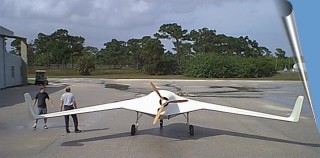 At
long last, the website is updated!
At
long last, the website is updated!
On January 10th, 2003, while performing high-speed taxi
tests in gusty conditions, combined with "nose bounces" to test
control responsiveness, the Atlantica prototype became airborne
when a bounce coincided with a substantial down-the-runway gust.
The power was immediately chopped, but the aircraft quickly
climbed to near 100 feet AGL, when the gust died.
Lacking airspeed and power, the Atlantica nosed over and
began to drop as the pilot applied full power to regain control
of the descent. The Atlantica began to recover but
impacted the runway at about 20-30 degrees nose down (analysis
based on damage patterns) and began to skid along the runway.
The ballistic chute switch was activated by the impact,
causing the chute to fire and inflate, and the winds and gusts
stopped the forward slide of the Atlantica and dragged it about
200 feet backwards and off the side of the runway.
The pilot suffered only minor injuries. The fixed
landing gear were sheared off by the impact, both wings
suffering cracks and damage from the gear being sheared off.
The main body suffered minor damage, mostly due to impact with
the collapsing front gear, and abrasions from the slide along
the runway.
Lack of funds has kept progress at a very slow burn since
the accident, but new pictures have been added showing the
aftermath and rebuilding, together with some analysis and
explanation of what the pictures show.
 Aftermath
and
Rebuilding,
NTSB Report and
Conclusions
Aftermath
and
Rebuilding,
NTSB Report and
Conclusions
Polyester
Mock up
Epoxy-Carbon
Prototype Pictures


